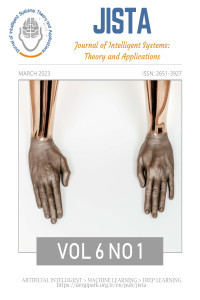Makine Öğrenmesi Yöntemleri ile Banka Müşterilerinin Kredi Alma Eğiliminin Karşılaştırmalı Analizi
Makine Öğrenmesi, Bankacılık, Kredi Tahminleme, Sınıflandırma Algoritmaları.
A Comparative Analysis of Bank Customers' Loan Propensity Using Machine Learning Methods
Machine Learning, Banking, Credit Estimation, Classification Algorithms.,
___
- Akar, Ö., & Güngör, O., 2012. Rastgele orman algoritması kullanılarak çok bantlı görüntülerin sınıflandırılması. Jeodezi ve Jeoinformasyon Dergisi, 1 (2), 139-146.
- Akşehirli, Ö. Y., Ankaralı, H., Aydın, D., Saraçlı, Ö., 2013. Tıbbi Tahminde Alternatif Bir Yaklaşım: Destek Vektör Makineleri. Turkiye Klinikleri Journal of Biostatistics, 5(1).
- Alan, A., 2020. Makine öğrenmesi sınıflandırma yöntemlerinde performans metrikleri ile test tekniklerinin farklı veri setleri üzerinde değerlendirilmesi (Master's thesis, Fen Bilimleri Enstitüsü)
- Ali, J., Khan, R., Ahmad, N., & Maqsood, I., 2012. Random forests and decision trees. International Journal of Computer Science Issues (IJCSI), 9(5), 272.
- Arun, K., Ishan, G., & Sanmeet, K., 2016. Loan approval prediction based on machine learning approach. IOSR J. Comput. Eng, 18 (3), 18-21.
- Biau, G., & Scornet, E., 2016. A random forest guided tour. Test, 25 (2), 197-227.
- Burges, C. J., 1998. A tutorial on support vector machines for pattern recognition. Data mining and knowledge discovery, 2(2), 121-167.
- Coşkun, S., Kartal, M., Coşkun, A., & Bircan, H., 2004. Lojistik regresyon analizinin incelenmesi ve diş hekimliğinde bir uygulaması. Cumhuriyet Üniversitesi Diş Hekimliği Fakültesi Dergisi, 7 (1), 42-50.
- Field, A., 2013. Discovering statistics using IBM SPSS statistics. sage.
- Gök, M., 2017. Makine öğrenmesi yöntemleri ile akademik başarının tahmin edilmesi. Gazi Üniversitesi Fen Bilimleri Dergisi Part C: Tasarım ve Teknoloji, 5 (3), 139-148.
- Kılınç, D., Borandağ, E., Yücalar, F., Tunalı, V., Şimşek, M. & Özçift, A., 2016. KNN Algoritması ve R Dili ile Metin Madenciliği Kullanılarak Bilimsel Makale Tasnifi. Marmara Fen Bilimleri Dergisi, 28 (3), 89-94. DOI: 10.7240/mufbed.69674
- Rasjid, Z. E., & Setiawan, R., 2017. Performance comparison and optimization of text document classification using k-NN and naïve bayes classification techniques. Procedia computer science, 116, 107-112.
- Serengil, S. I., Imece, S., Tosun, U. G., Buyukbas, E. B., & Koroglu, B., 2021. A Comparative Study of Machine Learning Approaches for Non Performing Loan Prediction. In 2021 6th International Conference on Computer Science and Engineering (UBMK) (pp. 326-331). IEEE.
- Zhang, Z., 2016. Introduction to machine learning: k-nearest neighbors. Annals of translational medicine, 4 (11)
- Başlangıç: 2018
- Yayıncı: Özer UYGUN
Emirhan KIRAN, Bahadir KARASULU, Emin BORANDAG
Makine Öğrenmesi Yöntemleri ile Banka Müşterilerinin Kredi Alma Eğiliminin Karşılaştırmalı Analizi
Ali Tezcan SARIZEYBEK, Onur SEVLİ
Grid Arama Yoluyla Monotonik Olmayan Hiperparametre Planlama Sisteminin Yardımcı Öğrenimi
Tekrarlayan Sinir Ağları Temelli Rüzgâr Hızı Tahmin Modelleri: Yalova Bölgesinde Bir Uygulama
Zeliha Nur KİRİŞ, Ömer Faruk BEYCA, Fuat KOSANOĞLU
Using Machine Learning Algorithms for Jumping Distance Prediction of Male Long Jumpers
Murat UÇAR, Mürsel Ozan İNCETAŞ, Işık BAYRAKTAR, Murat ÇİLLİ
Sınıflar Arası Kenar Payını Genişletmek İçin Yeni Bir Örnek Seçim Algoritması
Bireylerin Koroner Arter Hastalığı Risk Seviyesinin Bulanık Uzman Sistem Yaklaşımı İle Belirlenmesi
